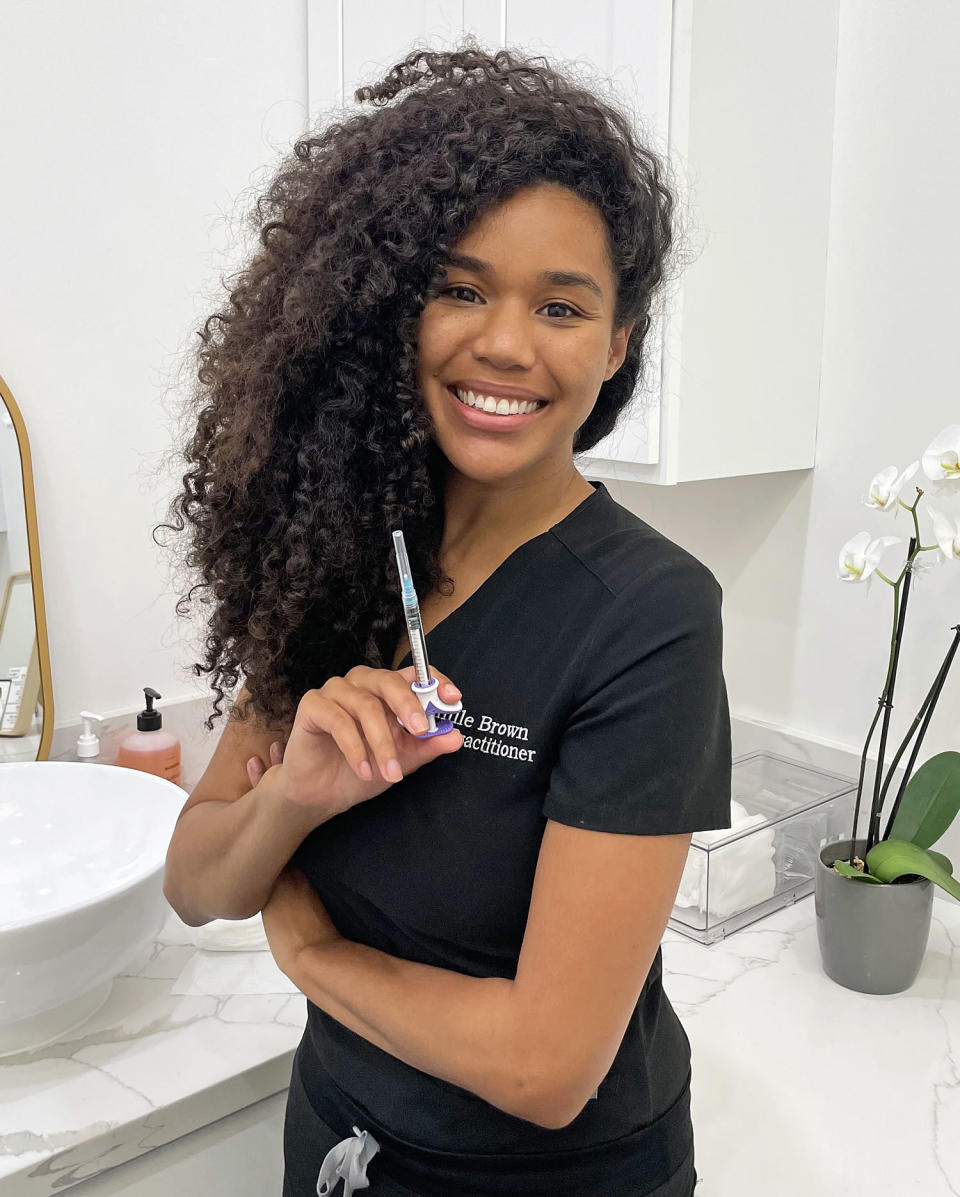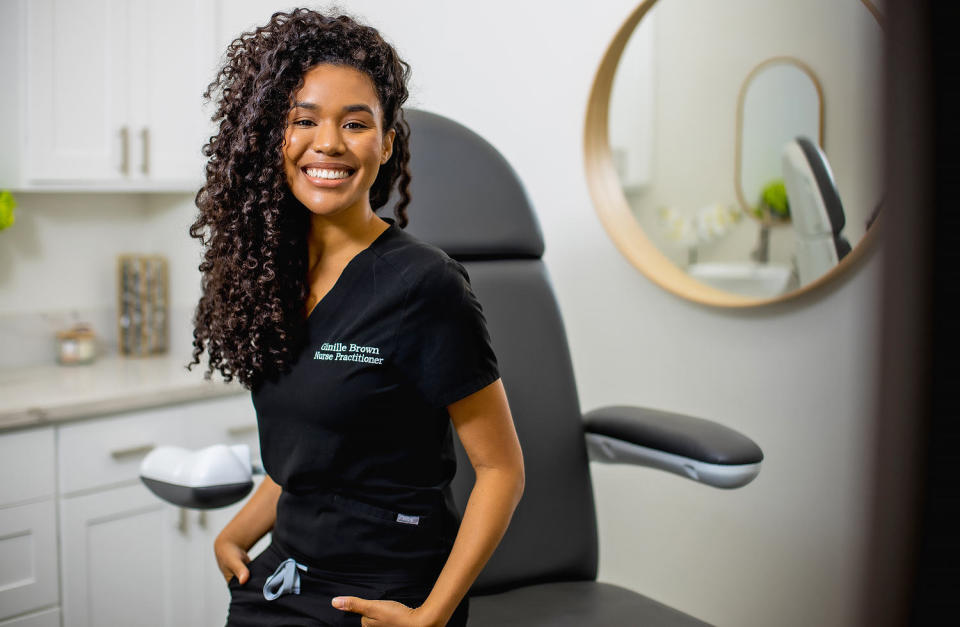What people of color need to know before getting Botox or filler, according to a nurse injector
Ginille Brown’s plan was to work in family medicine or an emergency room. But when someone suggested looking into a position at a med spa specializing in cosmetic procedures, the work quickly caught her attention.
As a nurse practitioner, Brown admits she judged the aesthetics field at first, assuming it was a space reserved for celebrities and whoever gets to count themselves among high society, Brown tells TODAY.com. She soon realized, however, it was “regular people getting treatments, and they were telling me their stories about why they get them and how it helps them to feel their best selves,” Brown says. "I really liked the human side of it.”
So, Brown leaned in. She started working at the med spa part time and a few years later decided to dedicate her career to the field.

It didn't take long for her to notice a trend among who came in for procedures, who created the tools used, and whom those tools were designed for and tested on. Spoiler: It was rarely people of color.
According to 2020 data collected by the American Society of Plastic Surgeons, 66% of people who undergo cosmetic procedures, including nonsurgical, were Caucasian. Hispanic patients made up 13%, African Americans 11%, Asian Americans 8% and those who identify as other made up 2%.
What's more, Brown discovered that the research behind many procedures and products only looked at white skin tones. So when she founded her own med spa, she was determined to offer safe and effective treatments to all clients, including those of color.
With 11 years of aesthetic work under belt and two spa locations in California with a diverse clientele and staff, Brown has seen firsthand the differences between the needs of people of color and white people when it comes to Botox, fillers and other procedures.
And she's committed to embracing those differences in her business, even if that means refusing to use certain popular machines and testing products on herself before her clients — all of which is worth it, she says.
“I have made it my mission to promote diversity in medical aesthetics,” Brown explains. “Through daily educational social media content featuring people of diverse backgrounds receiving these treatments, dispelling myths and answering questions, I strive to create an inclusive environment where everyone feels they belong and can confidently pursue these treatments.”
Cosmetic procedures on people of color
It’s not so much that non-white skin tones can’t tolerate certain procedures but that administration of the products and dosage can be different, according to Brown.
While her practice offers microneedling, facials and acne treatments, patients mostly come to Brown and her team for injectables, such as fillers or Botox for fine lines, TMJ and migraines. Brown finds that she often performs these procedures differently on patients of color by using different dosages, placement techniques or another product altogether.
“Usually, patients with ethnic backgrounds have more volume in their faces,” Brown says. “So, I have to use the products sometimes differently than how they are marketed and (what) their research and their clinical trials (indicate) to get a result on my patient that will be visible.”
If two clients were to receive the same amount of cheek filler, it might be more visible on one than another — often due to ethnic background, which can affect skin thickness, and facial structure and fullness.
In addition to these aspects of the skin and face, skin color itself should be an important consideration when administering cosmetic procedures, though it often isn't, Brown says. For example, people of color have been burned by lasers that weren’t created with them in mind. It’s precisely these risks that Brown is aiming to avoid.
“Different races have different features, different cultural ideals of beauty, different skin needs, which is why it’s important to have diversity in this space, so providers can safely and effectively treat people of diverse backgrounds,” she explained in a TikTok video.
To live up to this standard, Brown has an intense vetting process for the procedures she provides.
“I do a lot of research before I commit to any treatments,” Brown says, including testing the on herself. Black and Filipino, Brown’s own skin makes a great sample. She'll also try them on family members and other people she trusts to give honest feedback.
When Brown reviews the clinical trials for new devices and products, she takes a close look at demographics.
“I have found, being in this industry for a long time, the companies don’t always have their own research on people of color. And so, I take a lot of time before bringing something on," she explains.
Brown will consider a device for as long as year before bringing it into her practice if she’s not satisfied with the early data. It’s a process that requires her to call on her network of fellow providers and ask about the results they’ve seen on patients of all ethnicities.
How to find the practitioner for you
Brown’s clients often tell her how important it is to them that her staff is diverse. “Patients will tell me they just want to feel safe, they want to feel seen, heard, understood. And having an experience where they can just be themselves is important,” says Brown.
But your practitioner doesn’t have to be a person of color, Brown points out. They just have to consider the various practices your background might call for. “Say, ‘Please, can I see other people that look like me in your before and after (photos)?” Brown recommends patients ask during any consultations.
Brown conducts a virtual consultation with every client and examines them again once they come into the office.
Next, Brown says to do your own research. You might be responsible for some of the heavy lifting to make sure you’re getting the best treatment available. She recommends researching the device your practitioner recommends for you and searching for testimonials from patients of color.
Ask questions, Brown stresses. “Ask what are the risks with this? If we do happen to have one of these rare medical complications, how do we solve it? Am I a good candidate for this and why? What other treatments should I consider, if any, and why?” Brown says. “And I would consult with multiple providers before making a decision.”
She also warns against being swayed by specials and discounts. While a great deal is a bonus, make sure the person working with your skin is prepared to because repairing damage is time-consuming and costly. And beware of those who try to talk you into a procedure. All consultations should be a conversation, and the choice about whether you’d like to proceed is yours.
A practitioner might turn you away, Brown warns. But, she says, it’s better than being someone’s trial run.
“In general and historically, (medical aesthetics) really hasn’t been geared toward people of color,” Brown says. “And so, the research that goes behind it, the trainers who are training on the products, who they’re marketing to, it’s typically not skin of color, so I want (clients) to be hyperaware of these things and make sure they’re in a spot where they’re going to feel safe and seen and taken care of.”

Brown’s noticed a shift in recent years as more people of color elect to receive nonsurgical cosmetic treatments. That, she suspects, is due to “increased visibility and awareness,” she says. “As they actively research solutions for concerns like dark circles and smile lines, they encounter discussions about nonsurgical options,” primarily on social media by people who look like them.
She recognizes that cosmetic companies are improving, too. “Cosmetic injectable companies are emphasizing diversity in their marketing efforts, showcasing people of color undergoing these treatments, which further contributes to the rising trend among women of color.”
For now, a patient might have to drive a bit a farther for their injectables or research for a few months before landing on a practice and practitioner with whom they feel safe, and “that might be worth it,” says Brown. “It’s your face.”
This article was originally published on TODAY.com

